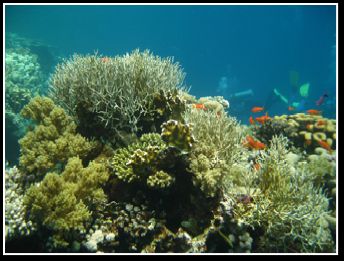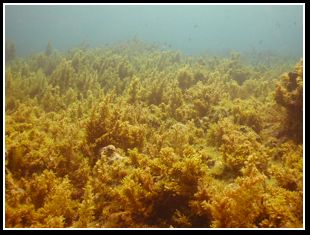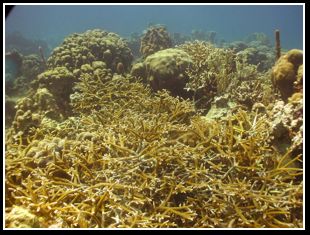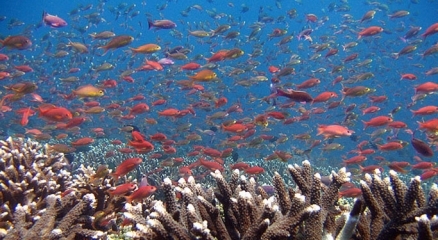Coral reef resilience
Coral reefs around the world are declining due to a variety of anthropogenic influences including: overfishing, pollution from agriculture and wastewater runoff, sedimentation from coastal development and deforestation, and changes in temperature, salinity, and alkalinity due to climate change (Coral reefs and climate change).
 A healthy coral dominated ecosystem. (Photo credit: Lindsey Feldman)
A healthy coral dominated ecosystem. (Photo credit: Lindsey Feldman)
Estimates have shown that by 1998, approximately 11% of the world’s coral reefs had been destroyed by direct human activity such as overfishing and another 16% were damaged due to coral bleaching predominately due to global warming. The increase in coral bleaching events has shown that reefs are threatened by global-scale climate change in addition to localized threats such as runoff and overfishing.
In response to what has been dubbed “the coral crisis” local authorities, non-governmental organizations, and governments are passing legislation that protects coral reefs and ensures their existence for aesthetic and economic value. A common method of preserving coral reefs employed by reef managers is the designation of coral reef ecosystems that are the most resistant and resilient as marine protected areas in order eliminate localized stressors. This also allows the reefs to be more resistant to global stressors that are not easily managed.
Contents
Reef resistance
Reef resistance is how well a coral reef is able to tolerate disturbances such as rising [[temperature]s] or the degree to which such impacts alter reef communities and ecosystems. Corals are often resistant to natural stresses and disturbances because they have naturally adapted to living in stressful environments. Corals in the shallow Red Sea, for example, can withstand much higher temperatures than corals anywhere else in the world without bleaching. This may be due to physiological adaptations to temperature extremes or other adaptations such as antibiotic enzymes or certain fluorescence pigments which allow corals to be more resistant to disease or increased UV radiation.
In addition to acclimation, local upwelling, currents, and shading all are major factors in reef resistance. Local upwelling can aid in the resistance of corals reefs by acclimating the organisms to a variety of temperatures and sediment loads. Currents act in a similar manner, as currents washing over reef systems are often of a different temperature and makeup than the local water. Shading by ledges or even other corals could increase resistance by providing cover for corals that are particularly sensitive to high levels of UV radiation. Each of these resistance mechanisms increases the chances of coral survival when exposed to stressful environments or catastrophic events.
Another possible resistance factor is known as the ‘adaptive bleaching hypothesis’; this theory suggests that corals can self select for a specific strain of heat-tolerant zooxanthellae which allow them to be more resistant to ocean warming. The adaptive bleaching hypothesis is still being investigated but if corals can in fact obtain zooxanthellae that are more heat-tolerant, they will be more likely to adapt and survive in the face of climate change (Coral reefs and climate change).
Reef resilience
Coral reef resilience is the ability of the ecosystem to recover from natural or anthropogenic disturbances. Coral resilience is often measured as the ability of coral colonies to regenerate after a coral bleaching event. For example, in Bolinao, Pangasinan in the northwestern Philippines, a global bleaching event caused near 100% mortality of the corals on the reef slope. Over a decade later, the same reef slope is thriving with corals.
Resilience factors can be grouped into two categories: ecological and spatial.
Ecological factors are the species and functional diversity of the reef ecosystem. Species diversity is the variety of different species that make up the coral reef ecosystem, anything from corals themselves to fish, invertebrates, and algae.
Functional diversity (aka response diversity), on the other hand, is the variety of roles the organisms living within the reef ecosystem play; these roles include top predators such as large fish and sharks, herbivores such as parrotfish or sea urchins, structure builders like corals, and many more. For example, coral reef diversity and species abundance is often dependant on a wide array of herbivorous fish and invertebrates that keep the amount of algae on the reef in check. (See section below on reef resilience and phase shifts).
Those reefs exhibiting both high levels of species and functional diversity are thought to be the most resilient, although this hypothesis has never been tested. Spatial resilience is the other main factor in determining total reef resilience. Spatial factors that effect resilience include genetic diversity and connectivity between reefs for larval dispersal and larval recruitment. Corals and fish release eggs by spawning and larval dispersal is often subject to tidal and current patterns. In order to ensure for the success of the larvae, there must be suitable habitat located within the dispersal range. This is very important for managing coral reefs in that successful marine protected areas must be designed with genetic diversity and connectivity in mind. Coral reefs with high levels of both spatial and functional diversity are usually thought of as the most resilient to disturbances in their natural environment.
Reef resilience to phase shifts
 Macroalgal-dominated reef. (Photo credit: John Bruno) Macroalgal-dominated reef. (Photo credit: John Bruno)
|
 Coral-dominated reef. (Photo credit: John Bruno) Coral-dominated reef. (Photo credit: John Bruno)
|
Reef resilience can also be defined as the ability of a coral reef ecosystem to resist phase shifting. Coral reef ecosystems are known to experience shifts in species composition; these changes are usually from coral-dominated to macroalgae-dominated systems. This change in species composition is often called a regime or phase shift.
Phase shifts occur when there is some kind of disturbance, whether it is natural or anthropogenic, to the marine environment. Drivers of phase shifts on coral reefs include bleaching events and overfishing of herbivorous fish that keep algae levels low. Once herbivorous fish populations decrease, algae often out-competes coral species weakened by bleaching and a coral dominated ecosystem becomes dominated by algae.
A large part of managing for resilience in coral reef ecosystems is the avoidance of these types of phase shifts.
Reef resiliency and implications for management
Determining the resiliency of a coral reef is especially important for reef managers with an allotted amount of time and funding. Often, those reefs with the highest predicted or measured resiliency are those targeted for marine protected areas or reserves. Within the Florida National Marine Sanctuary, there is a reef resilience program which aims to increases the resiliency of reefs within the sanctuary.
The Nature Conservancy advocates using resilience factors to manage coral reef ecosystems using marine protected areas, conserve essential sources of larvae for reef replenishment, preserve connectivity in order to enhance nearby damaged reefs, and decrease the occurrence and impacts of catastrophic events. The ability of managers to create marine protected areas and preserve resilient regions is dependent on their ability to identify the most resilient reefs.
Identification factors are based on the previously mentioned resistant and resilience factors in addition to the history of reefs which have been show to be resilient to previous disturbances. Although previous resilient sites can be chosen for protection, it is just as important for managers to increase resilience by decreasing overfishing and marine resource harvesting as well as pollution, erosion, and runoff from land degradation. Although managing for resilience may not be easy, it is necessary for ensuring the health and long-term survival of the world’s coral reefs.
Managing for resilience
In the past, reef managers have struggled with how best to ensure resiliency in coral reef ecosystems. Reef management was, and still is, conducted by making the best possible decisions with very little information about the socio-economic, biological, and ecosystem properties. Although this precautionary principle approach does ensure that coral reefs are being protected in some capacity, it is not always the most efficient or effective way of ensuring reef resiliency.
Adaptive management, a relatively new management strategy, uses a more scientific method of management that promotes learning and information gathering of the ecosystem being managed. Using adaptive management, reef managers recognize uncertainties, develop, and then test hypothesis in order to learn more about the reef. The more information collected, the more likely the reef will be managed effectively. Adaptive management is an open process that includes stakeholders from multiple disciplines that are relevant to managing reef resilience, including persons from ecological, social, political and cultural backgrounds. This process ensures that coral reef resilience is being increased and that corals are more likely to recover from possible disturbances by many facets.
Further Reading
- IUCN Guide to Coral Bleaching and Resilience
- A Reef Manager’s Guide to Coral Bleaching: Bleaching and Resilience section
- Hughes, T., M. Rodriques, D. Bellwood, D. Ceccarelli, O. Hoegh-Guldberg, L. McCook, N. Moltschaniwskyj, M. Pratchett, R. Steneck, and B. Willis. 2007. Phase Shifts, Herbivory, and the Resilience of Coral Reefs to Climate Change. Current Biology 17, 360-365.
- Resilience Alliance
